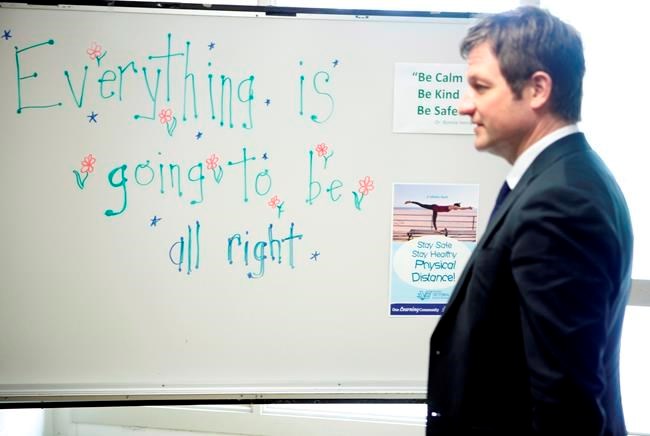Students will go back to class by Sept. 10, two days later than originally planned, says B.C.’s education minister.
Rob Fleming said Wednesday that the gradual restart will give students and staff added time to familiarize themselves with health-and-safety measures aimed at controlling the spread of the COVID-19 pandemic.
Staff will meet with schools’ health-and-safety committees beginning Sept. 8 to give staff the time to adjust to new routines and finalize lesson plans.
“We arrived at the two days after discussions with all the leaders of all the major partner groups in B.C.,” Fleming said on Wednesday. “This is the best scenario, I think, to continue to build the confidence and familiarity with the protocols that are in place.”
He said outdoor education will play a large role in the first two months of classes and emphasized the importance of students returning to schools to continue their education.
“We can’t sacrifice 18 months of education — we have to learn how to do things safely during this pandemic,” Fleming said. “That’s why we’ve developed and evolved the guidelines to maximize the return to in-class instruction.”
He acknowledged that some parents will not feel comfortable sending their kids back to school and the province’s distributed learning centres would help those who have concerns.
School districts will individually set the hours of the first two days back in school, Fleming added.
Premier John Horgan said he understands the concerns some people have about reopening schools.
“I absolutely get that there is anxiety in the community,” he said. “It’s not just about K-12 — for many people it’s extremely difficult and filling them with anxiety to go to the grocery store to get their basic needs filled on a weekly basis.
“We are in a global pandemic, we need to be cautious, we need to be aware. We don’t want to be fearmongers, but we want people to recognize that there is no immunity at this point in time, there is no vaccine at this point in time.”
Measures such as physical-distancing, frequent hand-washing and limiting contacts remain important, Horgan said. “That sounds counter to opening up our K-12 system but we, unlike every other jurisdiction in North America, have the benefit of a month of activity in June that has allowed us to shape what we believe the fall can look like,” he said. “We have taken a pause to allow educators to get into the schools and prepare for the first two days of the school year.”
Going back to school is a memorable occasion each September, Horgan said.
“This is an extraordinary time,” he said of life during the pandemic. “Our children are going to be extraordinary because of this time we’re living in.”
Horgan said adjustments will be made “as required” during the school year, while recognizing that every school and every district are different.
“As I’ve said repeatedly, what’s needed in Salmon Arm is not the same as what’s needed in Saanich or Salmo in the Kootenays.”
Greater Victoria Teachers’ Association president Winona Waldron was pleased with the prospect of more lead time for teachers but said she is disappointed that only two days have been allocated. More time is needed for “walk-through planning” to acclimate teachers to new ways of doing things, she said.
She suggested having more preparation time at elementary schools during the first week, along with a staggered start for the students.
Secondary schools should have their openings delayed for a week, Waldron said. “They’re going to have to rework the whole schedule.”
She said the system that sees secondary students attend four classes per semester won’t work in the current situation because they would come in contact with too many people.
“The teachers need an opportunity see how that looks,” she said.
In-person learning in B.C. was called off March 17 due to COVID-19. Optional, part-time school openings were offered in June, in part to give the province a dry run for restarting classes in September.
The government is spending $45.6 million on safety measures, including increased cleaning of high-contact surfaces, an increased number of hand-hygiene stations and boosting the availability of masks.
A government steering committee, established to help schools plan their restart, will issue operational guidelines next week on issues ranging from health and safety protocols to supporting the mental health of students.
Students will be organized into “cohorts” to reduce the number of people they come in contact with. The learning groups will be made up of about 60 people in elementary and middle schools, and about 120 in secondary schools.



